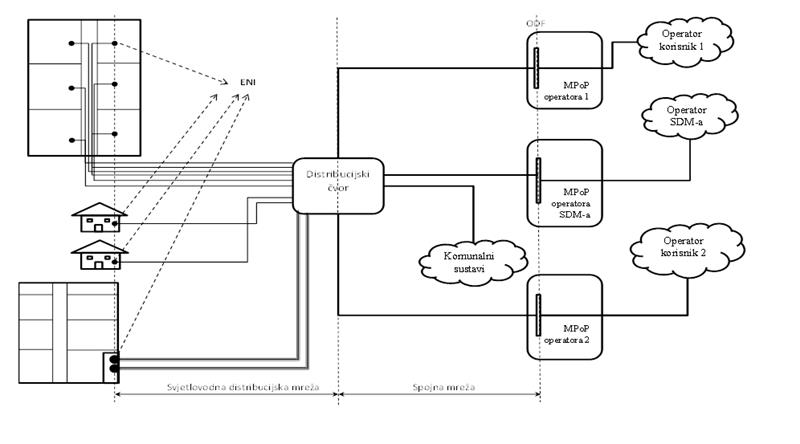Optical Distribution Networks (ODN)
A fibre, or fibre-optic strand, is made of glass or plastic, with a thickness comparable to a human hair that transmits a light signal. Compared with current networks based on copper media, fibre-optic networks:
A distribution node (DN) is the point where the ODN cable is concentrated on one side and the access fibre-optic cables of the connecting network on the other. The DN can be located in a standard street cabinet or within a building’s technical space, which houses electronic communications network equipment.
The FODN begins at the DN and terminates at the external network interface (ENI) of the external access electronic communications network, that is, at the demarcation point which defines the boundary between the cabling of the external (public) access network and the cabling of the building’s electronic communications network for the user unit (see Figure 1). The ENI may be located within the end user’s premises (apartment or business premises) or in the building’s entrance cabinet.
Figure 1. Schematic diagram of a fibre optic distribution network (FODN)
- enable significantly higher speeds;
- allow data transmission over long distances with almost no signal attenuation, regardless of the location of a residential or business premises, while requiring considerably less energy;
- are immune to electromagnetic interference, ensuring better quality.
A distribution node (DN) is the point where the ODN cable is concentrated on one side and the access fibre-optic cables of the connecting network on the other. The DN can be located in a standard street cabinet or within a building’s technical space, which houses electronic communications network equipment.
The FODN begins at the DN and terminates at the external network interface (ENI) of the external access electronic communications network, that is, at the demarcation point which defines the boundary between the cabling of the external (public) access network and the cabling of the building’s electronic communications network for the user unit (see Figure 1). The ENI may be located within the end user’s premises (apartment or business premises) or in the building’s entrance cabinet.
Figure 1. Schematic diagram of a fibre optic distribution network (FODN)

Ordinance on Fibre Optic Distribution Networks (ODN) prescribes the method of constructing (installing) a ODN as an open network that allows access and shared use by all service operators, with the aim of reducing costs and avoiding unnecessary duplication of networks. The investor, that is, the ODN operator, is, in accordance with the aforementioned regulation, obliged to publish the intention to install (construct) the ODN at least 60 days before the commencement of installation (construction). HAKOM publishes these notices of intention to install (construct) an ODN on its Interactive Portal.
Users wishing to gain access to and use an ODN for which a notice of intent to install (construct) has been published are required to express their interest in writing to the investor within 30 days of the notice’s publication. After this 30-day period, the investor negotiates the terms of access to and use of the fibre-optic distribution network with those users who have expressed interest and, in accordance with the Ordinance on the Methods and Conditions of Access to and Shared Use of Electronic Communications Infrastructure and Related Equipment, concludes an agreement on access to and use of the network.
In addition to taking into account and accommodating the expressed interest of other users in accessing and using the distribution node (DN) space, as well as other obligations prescribed during the design and construction of a DN, the investor is also required, for areas where the FODN coverage has a density exceeding 500 user units/km², to:
- Design and construct the MDF (Main Distribution Frame) so that it contains only one distribution cabinet (DC) with a minimum capacity of 300 user units,
- Connect each individual user unit to the DC via its dedicated fibre-optic line (point-to-point topology).